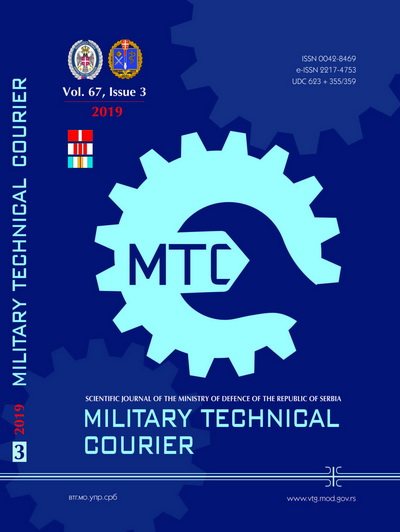Risk assessment framework: application of Bayesian Belief Networks in an ammunition delaboration project
Abstract
Models that represent real problems have been relying so far on historical data to draw upon conclusions. One negative aspect of these models was that they could not predict future states based on real data instantly collected or new sources of risk that suddenly appeared. To overcome this problem, this work presents the process of building a realistic predictive model using Bayesian Belief Networks (BBNs) and the AgenaRisk software. BBNs are a direct representation of real problems where their graphical structure represents real causal connections and not just a flow of information. Software tools providing algorithms for dealing with conditional probabilities have been developed. The Bayesian Theorem, a theoretical background for conditional probability, was also explained in the paper. Another benefit of using BBNs is that the reasoning process can operate by propagating information in any direction (top-down or bottom-up) which makes it a powerful tool in risk assessment and a decision-making process. The paper also provides the core principles and the power of BBNs and their application in the project planning phase for ammunition delaboration (resolving problems of surplus and obsolete ammunition in stockpiles), where risk assessment is one of the required processes which helps in making a final decision for project approval or not. The sensitivity and SWOT analyses are also performed as valuable and helpful tools for validation and making conclusions.
References
Andrejić, M., Đorović, B., & Pamučar, D. 2011. Managing project using a project management approach. Vojnotehnički glasnik/Military Technical Courier, 59(2), pp.142-175. Available at: https://doi.org/10.5937/vojtehg1102142A (in Serbian).
Constantinou, A.C., Fenton, N., Marsh, W., & Radlinski, L. 2016. From complex questionnaire and interviewing data to intelligent Bayesian network models for medical decision support. Artificial Intelligence in Medicine, 67, pp.75-93. Available at: https://doi.org/10.1016/j.artmed.2016.01.002.
Fan, C-F., & Yu, Y-C. 2004. BBN-based software project risk management. Journal of System and Software, 73(2), pp.193-203. Available at: https://doi.org/10.1016/j.jss.2003.12.032.
Fang, C., & Marle, F. 2012. A simulation-based risk network model for decision support in project risk management. Decision Support Systems, 52(3), pp.635–644. Available at: https://doi.org/10.1016/j.dss.2011.10.021.
Fenton, N., & Neil, M. 2011. The use of Bayes and causal modeling in decision makin, uncertainity and risk. [online] Available at: https://pdfs.semanticscholar.org/92dc/7cf5f483f5ebe9a0fffc5afe6e87bc5627e5.pdf. Accessed: 20.04.2018.
Fenton, N., & Neil, M. 2013. Risk Assessment and Decision Analysis with Bayesian Network. Boca Raton: CRC Press Taylor & Francis Group.
Gadeberg, M., & Luedeling, E. Can we build a better project: assessing complexities in development projects. [online] Available at: https://wle.cgiar.org/thrive/2016/06/01/can-we-build-better-project-assessing-complexities-development-projects. Accessed: 10.09.2016.
John, A., Yang, Z., Riahi, R., & Wang, J. 2016. A risk assessment approach to improve the resilience of a seaport system using Bayesian networks. Ocean Engineering, 111, pp.136–147. Available at: https://doi.org/10.1016/j.oceaneng.2015.10.048.
Landuyt, D., Broekx, S., D’hondt, R., Engelen, G., Aertsens, J., & Goethals, P.L.M. 2013. A review of Bayesian belief networks in ecosystem service modeling. Environmental Modelling & Software, 46, pp.1-11. Available at: https://doi.org/10.1016/j.envsoft.2013.03.011.
Lee, E., Park, Y., & Shin, J.G. 2009. Large engineering project risk management using a Bayesian belief network. Expert Systems with Applications, 36(3-Part2), pp.5880–5887. Available at: https://doi.org/10.1016/j.eswa.2008.07.057.
Malbašić, S., Tančić, L., & Petrović, V. 2016. Technology risk assessment as part of risk management process. Serbian Project Management Journal, 6(1), pp.51-62.
Marcelino-Sádaba, S., Pérez-Ezcurdia, A., Echeverría Lazcano, A.M., & Villanueva, P. 2014. Project risk management methodology for small firms. International Journal of Project Management, 32(2), pp.327-340. Available at: https://doi.org/10.1016/j.ijproman.2013.05.009.
Marcot, B.G., & Penman, T.D. 2019. Advances in Bayesian network modeling: Integration of modeling technologies. Environemntal Modeling & Software, 111, pp.386-393. Available at: https://doi.org/10.1016/j.envsoft.2018.09.016.
Raz, T., & Michael, E. 2001. Use and benefits of tools for project risk management. International Journal of Project Management, 19(1), pp.9-17. Available at: https://doi.org/10.1016/S0263-7863(99)00036-8.
Starr, C., & Shi, P. 2004. An Introduction to Bayesian Belief Networks and their Applications to Land Operations. [online] Available at: https://www.researchgate.net/publication/267240702_An_Introduction_to_Bayesian. Accessed: 15.09.2016.
Tang, A., Nicholson, A., & Jin, Y., & Han, J. 2007. Using Bayesian belief networks for change impact analysis in architecture design. Journal of Systems and Software, 80(1), pp.127-148. Available at: https://doi.org/10.1016/j.jss.2006.04.004.
Tien, I., & Der Kiureghian, A. 2016. Algorithms for Bayesian network modeling and reliability assessment of infrastructure systems. Reliability Engineering & System Safety, 156, pp.134-147. Available at: https://doi.org/10.1016/j.ress.2016.07.022.
Weber, P., Medina-Oliva, G., Simon, C., & Iung, B. 2012. Overview on Bayesian networks application for dependability, risk analysis and maintenance. Engineering Applications of Artificial Intelligence, 25(4), pp.671–682. Available at: https://doi.org/10.1016/j.engappai.2010.06.002.
Wright, E. 2011. Risk Management in Public Contracting. USA National Institute of Governmental Purchasing (under LEAP program).
Yet, B., Constantinou, A., Fenton, N., Neil, M., Luedeling, E., & Shepherd, K. 2016. A Bayesian network framework for project cost, benefit and risk analysis with an agricultural development case study. Expert Systems with Applications, 60, pp.141-155. Available at: https://doi.org/10.1016/j.eswa.2016.05.005.
Proposed Creative Commons Copyright Notices
Proposed Policy for Military Technical Courier (Journals That Offer Open Access)
Authors who publish with this journal agree to the following terms:
Authors retain copyright and grant the journal right of first publication with the work simultaneously licensed under a Creative Commons Attribution License that allows others to share the work with an acknowledgement of the work's authorship and initial publication in this journal.
- Authors are able to enter into separate, additional contractual arrangements for the non-exclusive distribution of the journal's published version of the work (e.g., post it to an institutional repository or publish it in a book), with an acknowledgement of its initial publication in this journal.
- Authors are permitted and encouraged to post their work online (e.g., in institutional repositories or on their website) prior to and during the submission process, as it can lead to productive exchanges, as well as earlier and greater citation of published work (See The Effect of Open Access).

